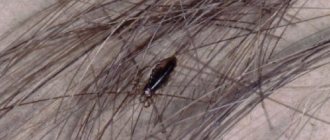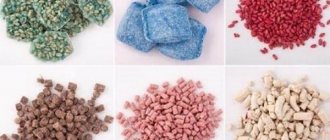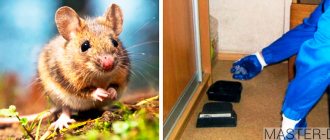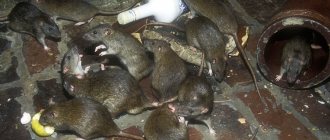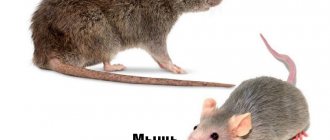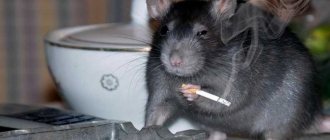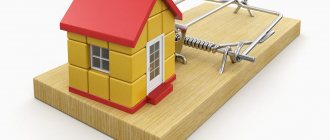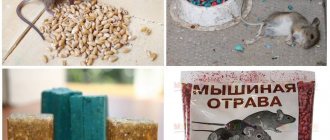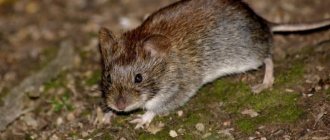An interesting phenomenon arose in the market for anti-rat drugs: sellers here were able to create demand for a product that they themselves had come up with. And this remedy is the so-called mummifying poison for rats.
It would seem, what is missing for buyers of rat poisons? There are quite effective poisons, and well-developed methods for reliably protecting pets from them, and the prices for such products are so low that everyone can use them.
However, there is an unresolved problem: rats decompose after death. And it is not at all uncommon for cases when, after the successful use of poison somewhere in an inaccessible place in an apartment, house or office, the corpse of a pest begins to mercilessly stink, making the room simply uninhabitable.
The photo below shows an example of a partially decomposed rat corpse:
Enterprising sellers quickly realized: if you promise the buyer that after a rat is poisoned, its corpse will not spoil the air in the room (due to decomposition), then such a drug will be much more in demand and will be easier to sell.
In general, this is how a rat repellent with a mummifying effect appeared on the market. According to sellers, it first poisons the pest, and then leads to a kind of preservation of the tissues of its body. As a result, the rat corpse does not decompose and does not stink, but simply dries out. Once they announced these properties of the poison, sellers discovered an active demand for it, and then quickly introduced such products into their permanent assortment.
On a note
It is not correct to say “mummified poison from rats and mice.” According to the rules of the Russian language, “mummified” is one who has himself turned into a mummy. For example, a rat or mouse can be mummified after it has died, but its body has dried out and not decomposed. The agent that provides this effect is mummifying. This means that the poison is mummifying, and not “mummified.”
Buyers understand the beauty of this effect and today are actively looking for mummifying rat poisons on sale - in the form of tablets, briquettes, poisoned grain, or drugs in other forms. At the same time, consumers do not even suspect that in fact, with statements about the “mummifying effect,” generally speaking, they are being led by the nose...
Everything you need to know about mummifying poisons
In fact, rat poisons with a mummifying effect, in the true sense of the phrase, do not exist on the market. The effect attributed to rodent poisons is simply an advertising ploy, a way to increase the attractiveness of the product, an empty promise and a feature made up by the seller.
The fact is that an inexpensive and competitive poison for rats, in principle, cannot be mummifying. To mummify the body of any animal, at least one of the following conditions must be met:
- Saturation of all animal tissues with substances that destroy decomposer bacteria;
- Or the corpse gets into conditions in which bacteria decomposing organic matter cannot exist.
An example of the first option is embalming the body, the results of which can be seen in the sarcophagi of the Egyptian pyramids or in the Mausoleum on Red Square in Moscow. An example of the second option is mummies of wild animals trapped in ice (it’s too cold for bacteria here), in the mud of swamps where there is no oxygen, or in very dry desert conditions where there is not enough moisture for the activity of decomposing microorganisms.
The second condition is unattainable in an apartment or office - microclimate parameters are always maintained here, quite normal for the decomposition of a rat corpse.
It is almost impossible to embalm a rat's body using poisoned bait, since such a procedure involves abundant saturation of the tissues with antibacterial agents. That is, you literally need to take a rat and soak it in a preservative.
On a note
Theoretically, mummification of a corpse can be achieved by adding special persistent broad-spectrum antibiotics to the poison, which do not decompose in the body for a long time. In this case, the rat will be killed by the poison, and the decomposer bacteria will be killed by the antibiotic. As a result, the corpse will not decompose (or the rate of decomposition will be very low) and will dry out faster than it stinks.
However, today there is no known poison for rats that contains such antibiotics. At a minimum, because such antibiotics are quite expensive - as a result, the poison would be very expensive and would not withstand competition in the market.
And now, perhaps, the most important thing: not a single official description and not a single instruction for rat repellents indicates their mummifying effect. This fact can be explained simply: drug manufacturers know very well that their products do not contain mummifying components and do not have the corresponding properties. They don't make anything up and are absolutely honest with customers. And non-existent properties are attributed to drugs by sellers who have little understanding of the theory, but skillfully use not entirely honest methods of increasing sales.
Review:
“I’m interested in this question: I look at the packaging of Storm, and there’s not a single word about mummification on it. And in the store the seller was straight up praising how good this mummified product was. I went to read on the Internet, half of the stores write that the product is mummified, half do not write this. There is a feeling that someone is coming up with something here..."
Tatiana, Tula
We conclude: no rat poison provides mummification of the corpses of dead rodents. However, there are quite a lot of products on sale that are positioned as mummifying. What effect then can be obtained from their use?
It’s also useful to read: 8 effective DIY rat traps
What products are sold as mummifying agents, and what is their real effect?
For example, the following are sold as mummifying poisons:
- Storm is perhaps the most popular remedy of this type. Contains flocumafen - in fact, a poison that, when released into the blood, blocks its clotting mechanism and causes the death of the animal due to multiple internal hemorrhages. The mummification effect for this substance is not known. Other components of the product are grain, dye and wax. So we can only wonder which ingredient out of all this is capable of turning a rat into a mummy. Storm's analogue is Goliath, the instructions for which say nothing about the mummifying effect;
- Mortorate, its active ingredient is brodifacoum. It acts similarly to Storm; in the official instructions from the manufacturer there is no mention of the mummifying effect;
- Nutcracker and Rat Death are analogues of Mortorate with the same active ingredient;
- Best is a drug based on bromadiolone. Its mummifying properties are also not known.
As we can see, there is no reason to believe that the corpse of a rat or mouse poisoned with one of these drugs will suddenly be mummified and become “inedible” for bacteria.
And yet, not only sellers, but also many buyers in reviews talk about the mummifying effect. But is this enough to believe in such an effect?
The active substance of the poison
There are two most common substances used in specialized poisons:
- Flocumafen;
- Brodifacoum.
Both of them are from the category of anticoagulants. The point is that when a warm-blooded animal (including a human, by the way) enters the protein body, the blood stops clotting.
In this case, abundant internal hemorrhages occur in the body.
However, the poison does not act instantly, naturally. The mouse will be sick for 2-3 days. Here it is important to indicate a special detail of the behavior of rodent pests. They never stay in a person’s home (do not live in it).
Mice come to humans only in search of food. Having received a dose of poison, the mouse runs away to a safe place (away from the house or apartment) and dies safely there. That is, the property owner will not have the above-mentioned problems with subsequent cleaning of the home from cadaveric poison.
Why do they say that mummifying poisons actually “mummify”?
In reality, the likelihood that a rat will die in an apartment or inside a private home is low. As a rule, animals make their nests outside residential premises: in basements or attics, in areas near houses, on dryers in apartment buildings, in hallways and garbage bins. Even from a powerful poison, they do not die immediately, but only after a few hours or even days, but when their condition worsens, they hide in their shelters. Here, near the nest, the cadaverous smell from the dead animal spreads.
Consequently, if a rat dies from poison not in the house, where it runs only in search of food, but outside it, then its corpse will not stink in the room itself. But a person who bought bait with a supposed “mummifying” effect will be sure that there is no smell precisely because the rats somewhere under the floor or behind the wall have turned into mummies. Although in fact they had already safely decomposed somewhere outside the apartment, they “stank” and all that was left of them were bones and wool.
And yet it happens that poisoned rats die inside apartments, offices, private houses and begin to stink mercilessly. Moreover, such situations often develop precisely after the use of “mummifying” poisons...
Review
“These mummifying rat baits don’t work! A rat died somewhere under the floor and it stinks so bad you can’t go into the house. At least don’t dismantle the whole floor now!”
Svetlana, St. Petersburg
It is also useful to read: The best types of rat traps for rodent control
How effective are poisons with this effect?
However, the products that are sold under the guise of “mummifying” are for the most part quite effective rat poisons, specifically designed to kill rodents and cope well with this task. Rats and mice die after eating them, and for the reasons stated above, the use of these products does not usually result in a decomposing odor in the premises. Although such preparations do not guarantee the absence of odor in the room, they are quite capable of killing a rat.
Therefore, Storm, Nutcracker, and all other products based on blood anticoagulants can be safely used in accordance with the instructions. They are laid out in those places in the room where rats and mice are most often, and new portions are added as the old ones are eaten by pests. Typically, rats die 3-4 days after they feed on such bait for the first time (sometimes, depending on the amount of poison eaten, the effect occurs earlier or later).
It is important to remember that most rat poisons are very toxic to pets and humans. Cats are especially sensitive to them. Therefore, baits are placed where pets cannot find them, ideally in special containers that only rats or mice can get into.
Review
“We are very pleased with the mummifying poisons. They have bred rats twice with them and they work great. They got rid of them once in the barn, once in the basement of the house. And indeed, there is no smell, the rats do not decompose. It’s better than if they lay somewhere and stink.”
Dmitry Pavlovich, Krasnodar
Precautionary measures
When working with toxic substances, you need to be careful, since rat poison is dangerous not only for rodents, but also for humans. A large dose of rodenticide can cause serious poisoning and death. If poison has somehow entered the human body, it is important to immediately contact a medical facility for help.
There are rules for using rodenticides:
- Before starting to work with baits, you should protect your hands with rubber gloves.
- The poison should be placed in places inaccessible to children and animals. It is best to place them in special containers for catching rodents.
- If the drug accidentally enters the body, you should immediately go to the hospital. Vikasol can be taken as an antidote to anticoagulants.
- The bait that remains after processing the room should be properly disposed of: buried to a depth of 50-100 cm or burned.
People over 18 years of age who are not prone to allergic reactions should work with rat poisons. Pregnant or breastfeeding women should not distribute rodenticides.
What else can you do to get rid of rats and mice so that there is no smell in the house?
So you can get rid of rats and mice in the house, so as not to suffer from cadaveric gases, in other ways. The best of them are mousetraps or rat traps, both crushers and those that catch animals alive.
After charging and installation, such a device should be checked regularly, and caught or killed animals should be removed from the apartment as far as possible. In this case, they definitely won’t stink up the room.
Also, many cats and some burrowing dogs - fox terriers and Jagd terriers - successfully catch rats and mice. They certainly won’t let their prey go to waste, although after a successful hunt and meal, pets may leave unaesthetic rodent paws or tails in the apartment.
You can’t just use poison at the same time and count on such helpers in the fight against rodents: even if a cat or dog doesn’t find poison, it can catch and eat a poisoned, but not yet dead rat, and poison itself. Therefore, for safety, you should first let a pet rat catcher into the room for 2-3 days, and if he can’t cope, then remove him and set traps or spread poison.
If you have personal experience with the use of “mummifying” poisons when fighting rats or mice, be sure to leave your review at the bottom of this page (in the comments field).
Useful video about using rat poisons
Rat and mouse bait Mortorat 150 g
Courier delivery is possible:
in Moscow, St. Petersburg, Khabarovsk
Effective bait for mice
Rodents have always created certain problems for people. And this applies not only to the feeling of subconscious fear at the sight of mice and rats, which is facilitated by a slippery and unpleasant appearance. Rodents can cause significant damage in the household, and sometimes it is very difficult to protect yourself from them. In addition, they are carriers of many unpleasant diseases, which greatly makes you think about purchasing a product to combat them. Many people try not to delay and buy Mortorat poison in order to get rid of rats and mice as soon as possible.
Not all remedies are effective and sometimes it is very difficult to find a truly fast-acting one. Today, an excellent option is mummifying bait against rats and mice, which you can easily buy in our online store. Mortorate is one of the most effective means for combating harmful rodents. This mummifying rat bait is very easy to use and effective in killing rodents that are sensitive to elements such as zoocoumarins and other rodenticides.
Application
If you decide to buy this product, then you need to know that the mummifying bait against rats and mice is sold in the form of soft briquettes. The method of application is quite simple, because to achieve maximum results it is enough to spread the drug in various places that can serve as shelter for rodents. The distance over which it is necessary to lay out the Mortorat should be at least 2 - 5 m. The mummifying bait against rats and mice can be laid more often, because it all depends on the number of rodents in the apartment and the clutter of the premises.
The effect of the drug is so strong that within 4-6 days the rodents die. In this case, the dead rodents are simply mummified and do not emit unpleasant odors. The peculiarities of the drug include the fact that rodents do not suspect anything and eat Mortorat without hesitation. To start the fight, you need to buy this product. It is worth remembering that mummifying bait against rats and mice can be dangerous to the health of pets and small children, so it is advisable to store Mortorat in a place inaccessible to children and pets. The mummifying bait against rats and mice must be laid out and dead rodents must be collected using gloves on your hands. It is advisable to burn and bury rodents that died after using Mortorat. The same must be done with the remains of the bait and containers. All that remains is to buy this product and start an effective “war” against rodents.
